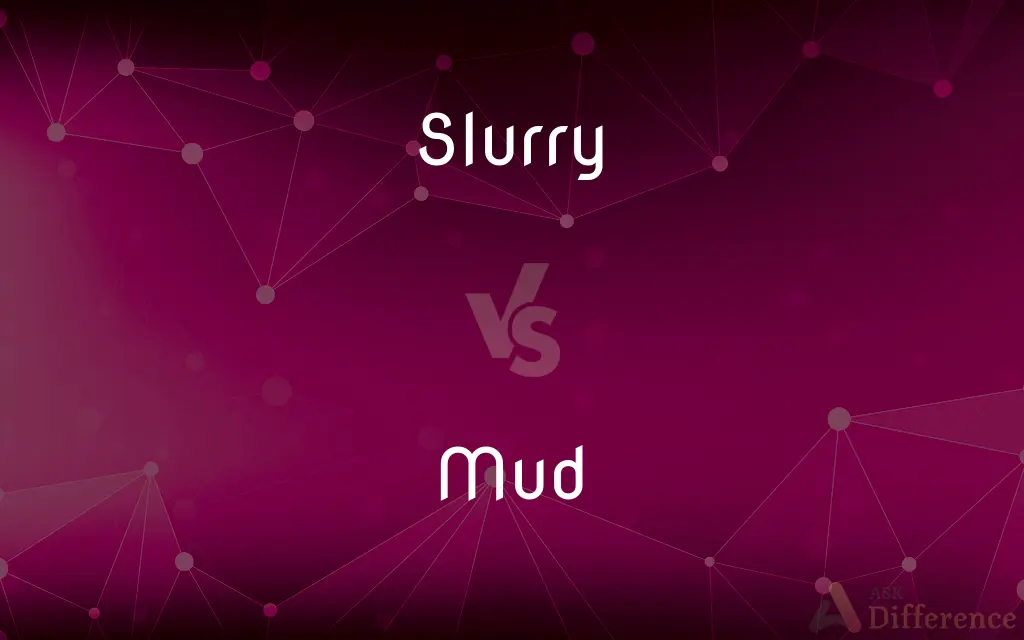Slurry vs. Mud — What's the Difference?
Edited by Tayyaba Rehman — By Maham Liaqat — Updated on March 22, 2024
Slurry is a mixture of solids suspended in a liquid, often used in industrial processes, while mud is a natural mixture of water and soil or fine particles, commonly found in natural environments.

Difference Between Slurry and Mud
Table of Contents
ADVERTISEMENT
Key Differences
Slurry is engineered for specific industrial or agricultural applications, containing a mixture of liquid and finely divided solids. These mixtures are often designed to facilitate transportation, processing, or disposal of materials. Whereas mud is typically a naturally occurring mixture, formed when water combines with soil, silt, or clay. It's common in riverbeds, marshes, and as a result of rain.
Slurry's composition is carefully controlled to suit its purpose, ranging from waste management in mining to concrete production in construction. Its consistency and particle size can be adjusted based on its intended use. On the other hand, the composition of mud is not controlled and varies widely based on its location and the natural materials available, affecting its texture and properties.
In industrial settings, slurry can be a byproduct or a primary product, designed for easy pumping and handling through pipelines. This fluidity is crucial for processes like the hydraulic transport of mined materials. Conversely, mud's consistency varies from liquid to semi-solid, and its handling is often related to environmental management, agriculture, or construction without the need for specific fluid properties.
Slurries may require treatment or specific handling procedures to prevent settling of solid particles or to manage chemical properties, ensuring consistency and effectiveness for their application. Mud, whereas, is often left to dry naturally or used as is in construction (e.g., mud bricks) or in beauty treatments, with little to no modification needed.
Environmental considerations play a significant role in the management of both slurries and mud. Slurries, especially from industrial or mining operations, can pose environmental risks if not properly handled or treated. Mud, on the other hand, can be part of natural processes, contributing to ecosystem function or requiring management in areas prone to flooding or erosion.
ADVERTISEMENT
Comparison Chart
Composition
Mixture of solids suspended in a liquid, often with chemical additives.
Natural mixture of water and fine particles like soil or clay.
Origin
Engineered for specific applications in industries or agriculture.
Naturally occurring, often as a result of weather or environmental conditions.
Consistency
Can be adjusted for specific uses, generally more fluid.
Varies widely from liquid to semi-solid, not specifically controlled.
Handling
Designed for easy transport and handling, often requires special treatment.
Natural handling, may dry naturally or used as is, no special treatment needed.
Environmental Impact
Requires careful management to prevent pollution.
Can be part of natural ecological processes or managed for construction.
Compare with Definitions
Slurry
An agricultural spray consisting of water mixed with manure or fertilizers.
The farmer sprayed the fields with a nutrient-rich slurry.
Mud
A natural plaster used in traditional building techniques.
The walls of the hut were made from straw and mud.
Slurry
A fluid mixture of water and fine particles used in industrial processes.
The factory processes ore by mixing it into a slurry for easier handling.
Mud
Sediment deposited by rivers or floods.
The flood left a layer of mud on the floors.
Slurry
A mixture used in construction to fill gaps or smooth surfaces.
Workers applied the slurry to the wall for a smooth finish.
Mud
A natural skin treatment sourced from mineral-rich earth.
The spa offers facials with healing mud from the Dead Sea.
Slurry
A liquid form of concrete used in construction.
The construction team poured slurry into the foundation form.
Mud
The condition of being muddy or dirty.
The festival was fun, but my clothes were caked in mud by the end.
Slurry
A suspension of insoluble particles used in wastewater treatment.
The treatment plant uses a slurry to remove contaminants from water.
Mud
A wet, soft earth or fine-grained soil mixed with water.
After the rain, the backyard was covered in thick mud.
Slurry
A slurry is a mixture of solids denser than water suspended in liquid, usually water. The most common use of slurry is as a means of transporting solids, the liquid being a carrier that is pumped on a device such as a centrifugal pump.
Mud
Mud is soil, loam, silt or clay mixed with water. It usually forms after rainfall or near water sources.
Slurry
A semi-liquid mixture, typically of fine particles of manure, cement, or coal suspended in water
A slurry of ore and water
Clay slurry
Mud
A computer-based text or virtual reality game which several players play at the same time, interacting with each other as well as with characters controlled by the computer.
Slurry
A thin mixture of a liquid, especially water, and any of several finely divided substances, such as cement, plaster of Paris, or clay particles.
Mud
A computer program, usually running over the internet, that allows multiple users to participate in virtual-reality role-playing games.
Slurry
Any flowable suspension of small particles in liquid.
Mud
Wet, sticky, soft earth, as on the banks of a river.
Slurry
(mining) Liquid waste from some types of mining, such as mountain top removal mining, usually very toxic and stored nearby in large dams.
Mud
(Slang) Wet plaster, mortar, or cement.
Slurry
(agriculture) A mixture of animal waste, other organic material and sometimes water, stored in a slurry pit and used as fertilizer; also used in combination, as pig slurry, etc.
Mud
Slanderous or defamatory charges or comments
Slinging mud at his opponent.
Slurry
(cooking) A thickener.
Mud
To cover or spatter with or as if with mud.
Slurry
To make a slurry (of some material).
Mud
A mixture of water and soil or fine grained sediment.
Slurry
To apply a slurry (to).
Next week we will be slurrying the parking lot.
Mud
A plaster-like mixture used to texture or smooth drywall.
Slurry
Slurred, tending to slur.
He spoke with a slurry voice.
His voice became progressively slurrier as he drank the three bottles of wine.
Mud
(construction industry slang) Wet concrete as it is being mixed, delivered and poured.
Slurry
A suspension of insoluble particles (as plaster of paris or lime or clay etc.) usually in water
Mud
(figuratively) Willfully abusive, even slanderous remarks or claims, notably between political opponents.
The campaign issues got lost in all the mud from both parties.
Mud
(slang) Money, dough, especially when proceeding from dirty business.
Mud
(geology) A particle less than 62.5 microns in diameter, following the Wentworth scale
Mud
A black person.
Mud
Drilling fluid.
Mud
(slang) Coffee.
Mud
(transitive) To make muddy or dirty; to apply mud to (something).
Mud
(transitive) To make turbid.
Mud
(intransitive) To go under the mud, as an eel does.
Mud
To participate in a MUD or multi-user dungeon.
Mud
Earth and water mixed so as to be soft and adhesive.
Mud
To bury in mud.
Mud
To make muddy or turbid.
Mud
Water soaked soil; soft wet earth
Mud
Slanderous remarks or charges
Mud
Soil with mud, muck, or mire;
The child mucked up his shirt while playing ball in the garden
Mud
Plaster with mud
Common Curiosities
What is slurry made of?
Slurry is made of a liquid (often water) mixed with finely divided solids, which can include minerals, chemicals, or organic matter depending on its use.
Can the composition of a slurry be controlled?
Yes, the composition of a slurry is carefully controlled to meet the requirements of its specific application, including the size of the suspended particles and the liquid's viscosity.
What makes mud different from slurry?
Mud is a natural mixture of water and soil, whereas slurry is an engineered mixture designed for specific industrial or agricultural applications.
Do slurries have environmental impacts?
Yes, industrial or mining slurries can have significant environmental impacts if not managed properly, including water pollution and habitat destruction.
How are slurries used in agriculture?
In agriculture, slurries are used as a form of liquid fertilizer or manure spread on fields to enrich the soil.
Can mud be used in beauty treatments?
Yes, certain types of mud, especially those rich in minerals, are used in spa treatments for their skin health benefits.
Where can mud be found?
Mud can be found in natural environments such as riverbeds, lakeshores, marshes, and areas with wet soil.
What uses does mud have in construction?
Mud is used in making bricks, plastering, and in traditional building techniques that utilize natural materials for construction.
What are the challenges in handling slurries?
Handling slurries can be challenging due to the need to prevent the settling of solids, maintain a consistent mixture, and manage any chemical properties.
What is a mud flood?
A mud flood occurs when heavy rain or melting snow mixes with soil, creating a flowing mixture of water and earth that can cover landscapes and fill structures.
Is mud harmful to the environment?
Naturally occurring mud is not harmful and is part of many ecosystems, but large accumulations can require management in certain contexts, like construction or flood recovery.
How is slurry transported?
Slurry is often transported through pipelines or in tankers designed for liquid materials, making it easier to handle than dry solids.
How are slurries beneficial in mining?
In mining, slurries allow for the efficient transport of materials, reducing the need for dry handling and facilitating the separation of valuable minerals from waste.
Are there any health risks associated with mud?
Natural mud is generally not harmful, but in urban or polluted environments, mud can contain contaminants that pose health risks.
Can both slurry and mud be artificially created?
While slurry is often artificially created for specific purposes, mud can be both naturally occurring and artificially created, such as in controlled agricultural or construction settings.
Share Your Discovery

Previous Comparison
Confusing vs. Ubiquitous
Next Comparison
Sail vs. VoyageAuthor Spotlight
Written by
Maham LiaqatEdited by
Tayyaba RehmanTayyaba Rehman is a distinguished writer, currently serving as a primary contributor to askdifference.com. As a researcher in semantics and etymology, Tayyaba's passion for the complexity of languages and their distinctions has found a perfect home on the platform. Tayyaba delves into the intricacies of language, distinguishing between commonly confused words and phrases, thereby providing clarity for readers worldwide.














































